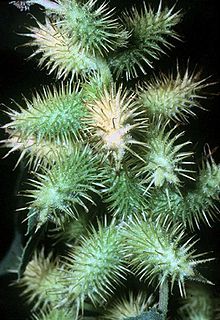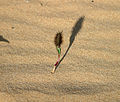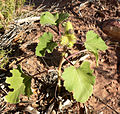- Cocklebur
-
Xanthium 
Xanthium strumarium Scientific classification Kingdom: Plantae (unranked): Angiosperms (unranked): Eudicots (unranked): Asterids Order: Asterales Family: Asteraceae Genus: Xanthium
L.Species See text.
Cockleburs (Xanthium) are a genus of flowering plants in the family Asteraceae, native to the Americas and eastern Asia.
Contents
Growth
They are coarse, herbaceous annual plants growing to 19.69-47.24 in (1.5 to 4 ft) tall. The leaves are spirally arranged, with a deeply toothed margin. Some species, notably X. spinosum, are also very thorny with long, slender spines at the leaf bases.
The flowers are of two types; One, in short terminal branches, produces only pollen. The other, in clusters in the axils of the leaves, produces seed.
Unlike many other members of the family Asteraceae, whose seeds are airborne with a plume of silky hairs resembling miniature parachutes, cocklebur seeds are produced in a hard, spiny, globose or oval double-chambered, single-seeded bur .32-.79 in long. It is covered with stiff, hooked spines, which sticks to fur and clothing and can be quite difficult to extract. These remarkable burred seeds have allowed this plant to be carried all over the world by unsuspecting travelers. This plant reproduces only by means of its seed.
Characteristics
Cockleburs are short-day plants, meaning they only initiate flowering when the days are getting shorter in the late summer and fall, typically from July to October in the northern hemisphere. They can also flower in the tropics where the daylength is constant.
-
Seedling struggling to take root among the sand dunes of West Texas
-
Closeup of fruit, Wilbur Hot Spring, Colusa County, California
Selected species
The number of species is disputed between different authors, with some recognising as few as three species in the genus.
- Xanthium ambrosioides
- Xanthium brasilicum
- Xanthium commune
- Xanthium echinatum - Stinking Cocklebur
- Xanthium inaequilaterum
- Xanthium inflexum
- Xanthium mongolicum
- Xanthium occidentale - Noogoora Burr
- Xanthium sibiricum - in Chinese (Chinese: 蒼耳; pinyin: chang-er)
- Xanthium speciosum
- Xanthium spinosum - Spiny Cocklebur, Burreed, Bathurst Burr. South and Central America.
- Xanthium strumarium - Clotbur, Rough Cocklebur, Large Cocklebur, Common Cocklebur. North America, extensively naturalized elsewhere. Syn. X. canadense, X. chinense, , X. glabratum
Dangers and uses
The Common Cocklebur (X. strumarium) is a native of North America where in the past the (now extinct) Carolina Parakeet fed on the seeds. It has become an invasive species worldwide. It invades agricultural lands and can be poisonous to livestock, including horses, cattle, and sheep. Some domestic animals will avoid consuming the plant if other forage is present, but less discriminating animals, such as pigs, will consume the plants and then sicken and die. The seedlings and seeds are the most toxic parts of the plants. Symptoms usually occur within a few hours, producing unsteadiness and weakness, depression, nausea and vomiting, twisting of the neck muscles, rapid and weak pulse, difficulty breathing, and eventually death.
The plant also has been used for making yellow dye, hence the name of the genus (Greek xanthos = 'yellow'). The many species of this plant, which can be found in many areas, may actually be varieties of two or three species. The seed oil is edible to humans.
Asian species of Xanthium also known as Cang Er Zi in Traditional Chinese Medicine. According to some studies, an active ingredient in Xanthium exhibits significant selective modulation of superoxide anion generation by human neutrophils induced by formyl-L-methionyl-L-leucyl-L-phenylalanine, with an IC50 value of 1.72 mcg/mL.[1]
This plant is a beneficial weed, repelling army worms and other pests from nearby domesticated plants.
See also
References
- ^ Lee, CL; Huang, PC; Hsieh, PW; Hwang, TL; Hou, YY; Chang, FR; Wu, YC (2008). "(-)-Xanthienopyran, a new inhibitor of superoxide anion generation by activated neutrophils, and further constituents of the seeds of Xanthium strumarium". Planta medica 74 (10): 1276–9. doi:10.1055/s-2008-1081295. PMID 18622908.
- Everitt, J.H.; Lonard, R.L., Little, C.R. (2007). Weeds in South Texas and Northern Mexico. Lubbock: Texas Tech University Press. ISBN 0-89672-614-2
- Robbins, W.W., M.K. Bellue and W.S. Ball. Weeds of California. State Department of Agriculture, Sacramento, California (1941).
Categories:- Asteraceae genera
- Poisonous plants
- Medicinal plants
- Xanthium
-
Wikimedia Foundation. 2010.



